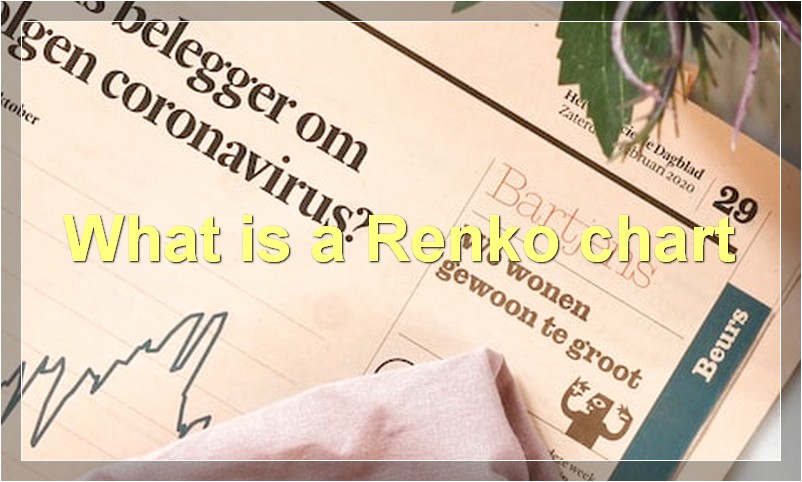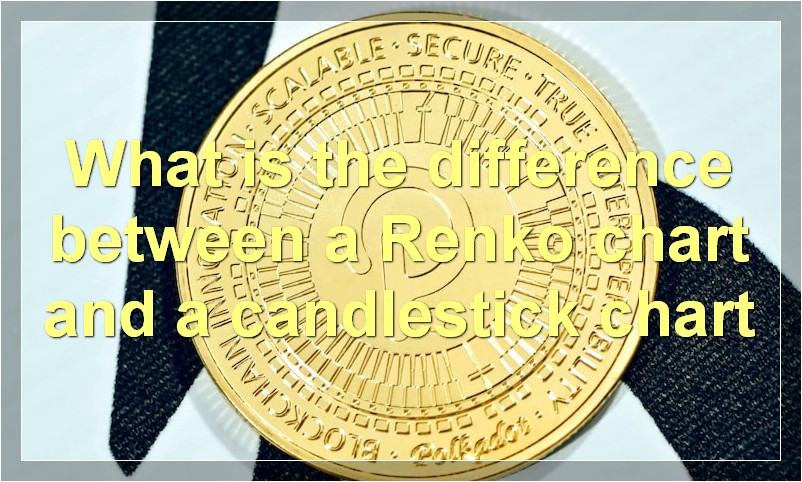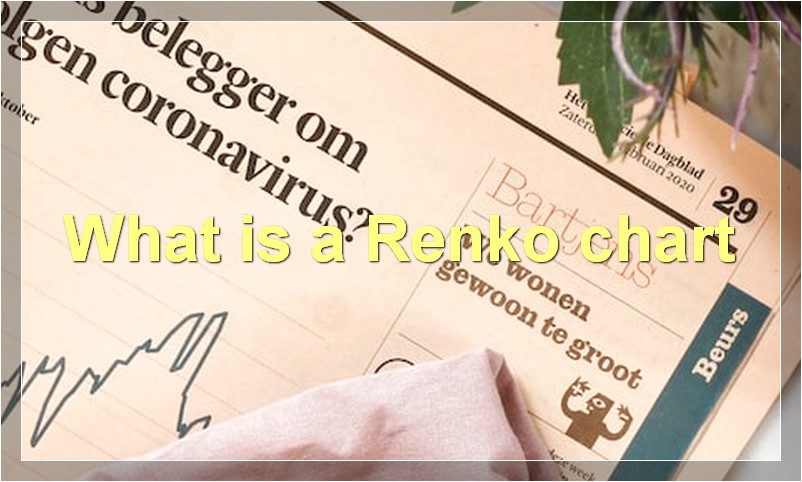If you’re looking for a complete guide to Renko charts, look no further! In this article, we’ll explain everything you need to know about these powerful tools.
What is a Renko chart

A Renko chart is a type of chart, typically used by traders in the commodities and Forex markets, that uses price movement rather than time or volume to create a graphical representation of price.
The name “Renko” comes from the Japanese word for bricks, which is how the chart looks when price moves up or down enough to create a new “brick” on the chart. Each brick represents a certain price move, and the size of the brick can be customized by the trader.
Renko charts are different from traditional candlestick or bar charts because they don’t take time into account. This means that a Renko chart can be used to trade any time-based market, from stocks to commodities to Forex.
Some traders prefer Renko charts because they believe that it eliminates noise from the market and makes it easier to spot trends. Others find Renko charts confusing and difficult to interpret.
If you’re interested in trying out a Renko chart, most trading software platforms will have them available. You can also find many websites that offer free Renko charts.
How to trade with Renko charts
Renko charts are a type of chart that is created by placing a brick in the next column once the price surpasses the top or bottom of the previous brick by a predefined amount. This predefined amount is called the box size. Renko charts are popular among traders because they can filter out small price movements and help to identify trends.
To trade with Renko charts, you will need to first identify the box size that you want to use. Once you have done this, you will need to place your buy and sell orders according to the movement of the bricks. For example, if you are using a 10 pip box size, you will place a buy order when the price moves 10 pips above the bottom of the previous brick, and you will place a sell order when the price moves 10 pips below the top of the previous brick.
It is important to remember that Renko charts can be subject to whipsaws, so it is important to use other indicators in conjunction with Renko charts to confirm trends.
What are the benefits of trading with Renko charts
Renko charts are a type of charting used by traders to predict future price movements. The word “Renko” comes from the Japanese word for bricks, which is what these charts look like when they are drawn out. Renko charts are created by plotting price movements in bricks of a fixed size, typically two or three times the average true range. These charts can be used to trade any time frame, but are most commonly used on daily or weekly charts.
There are several benefits of trading with Renko charts. First, they can help to identify trends more easily than other types of charts. Second, Renko charts can be used to trade both long and short-term time frames. Third, Renko charts can be used to trade multiple markets and asset classes. Finally, Renko charts can be customized to fit the needs of any trader.
How to construct a Renko chart
A Renko chart is a type of chart, developed by the Japanese, that is built using price movement rather than both price and time. The word “Renko” comes from the Japanese word for bricks, “renga”. In a Renko chart, a brick is created when the price moves up or down by a pre-determined amount. For example, if you have a brick size of $0.50, a brick will be created when the price moves up or down by $0.50 from the previous brick. Bricks are always created in a vertical line, and one brick will never touch another.
The benefit of using a Renko chart is that it can help to filter out some of the noise that can be present in other types of charts, such as candlestick or bar charts. This can make it easier to identify trends, as well as support and resistance levels.
To construct a Renko chart, you will first need to choose a brick size. This can be any value that you like, but it is important to be consistent with the size that you use. Once you have chosen a brick size, you will need to determine the opening price for the first brick. This can be done by taking the closing price from a candlestick or bar chart and rounding it up or down to the nearest brick size increment. For example, if the closing price on a candlestick chart was $1.23, and your brick size was $0.50, the opening price for the first brick would be $1.50.
Once you have determined the opening price for the first brick, you can begin constructing your chart. If the next price move is up by your chosen brick size or more, then you will add a new brick above the previous one, with the new high being used as the top of the new brick. If the next move is down by your chosen brick size or more, then you will add a new brick below the previous one, with the new low being used as the bottom of the new brick. You will continue to add new bricks in this way until all recent price action has been captured on your chart.
What is the difference between a Renko chart and a candlestick chart

When it comes to charts, there are a few different types that people use to track prices. Two of the more popular ones are Renko charts and candlestick charts. So, what’s the difference between the two?
Renko charts are based on price movement, rather than time like most other chart types. This means that a new “brick” is only added to the chart when price moves a certain amount. This makes it easy to spot trends, as well as support and resistance levels.
Candlestick charts, on the other hand, are based on time intervals. Each “candle” represents a certain amount of time, such as 1 minute, 5 minutes, 1 hour, etc. The benefit of this type of chart is that you can see more detailed price action. However, it can also be more difficult to spot overall trends.
So, which one is better? It really depends on what you’re looking for. If you want to see detailed price action, then candlestick charts are probably your best bet. However, if you’re more interested in spotting trends and support/resistance levels, then Renko charts might be a better choice.
What are some common trading strategies used with Renko charts
Renko charts are a type of charting technique that is used by traders to indicate the direction and momentum of a security. The name “Renko” comes from the Japanese word for bricks, which is what these charts look like. Each brick on a Renko chart represents a set amount of price movement, and the bricks are placed in either an up or down direction depending on the direction of the price move.
There are several different trading strategies that can be used with Renko charts. One common strategy is to buy when the bricks start to turn from red to green, and sell when they start to turn from green to red. This strategy can be used on any time frame, but is most commonly used on daily or weekly charts.
Another common strategy is to wait for a brick to close above or below the previous brick, and then enter a trade in that direction. For example, if the first brick is red and the second brick is green, you would buy if the second brick closed above the first brick. This strategy can also be used on any time frame, but is most commonly used on shorter time frames such as hourly or 15-minute charts.
These are just two of the many different trading strategies that can be used with Renko charts. If you are interested in learning more about this type of charting, there are many resources available online and in books.
How can Renko charts be used to identify support and resistance levels
Renko charts are a type of chart that uses price movement to create candlesticks. The key benefit of Renko charts is that they can be used to identify support and resistance levels more easily than other types of charts.
To identify support and resistance levels with Renko charts, you will need to look for areas where the candlesticks cluster together. These areas indicate that there is a strong level of support or resistance present.
You can also use trend lines to help identify potential support and resistance levels. Look for areas where the trend line is broken and then retested. These areas can provide potential support and resistance levels that you can watch for price action.
What are some potential drawbacks of trading with Renko charts
There are a few potential drawbacks to trading with Renko charts that traders should be aware of. First, because Renko charts only take into account price movement and do not factor in time or volume, some important information may be missed. Secondly, Renko charts can be choppy and may produce false signals. Finally, Renko charts can be difficult to interpret if a trader is not familiar with them.
Are there any software programs that can help construct or interpret Renko charts
There are a few software programs that can help construct or interpret Renko charts. One example is the MetaTrader 4 Supreme Edition plugin, which adds Renko charting capabilities to the MetaTrader 4 trading platform. Another example is the ProRealTime software program, which provides both live streaming data and historical data for constructing Renko charts.

